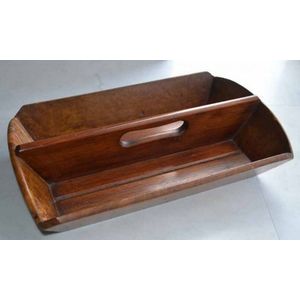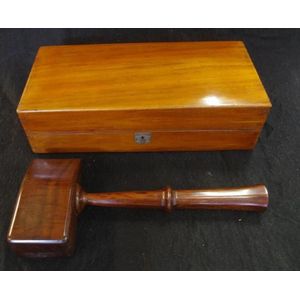Vintage Rosewood Gavel in Heraldic Crest Case
Vintage cased rosewood gavel, the timber case with heraldic crest keyhole escutcheon, 29 cm wide
You must be a subscriber, and be logged in to view price and dealer details.
Subscribe Now to view actual auction price for this item
When you subscribe, you have the option of setting the currency in which to display prices to $Au, $US, $NZ or Stg.
This item has been sold, and the description, image and price are for reference purposes only.
- Heraldic Decoration - Heraldic decoration on silver, glass, and porcelain refers to the use of coats of arms and other heraldic symbols as decorative motifs on these materials. Coats of arms were traditionally used to identify individuals, families, and institutions, and were often displayed on shields, banners, and other objects.
The heraldic decoration typically takes the form of engraved or etched designs that incorporate coats of arms or other heraldic symbols. Heraldic decoration on silver, glass, and porcelain has a long history, dating back to the medieval period when coats of arms were first used. During the Renaissance and Baroque periods, heraldic decoration on decorative objects became increasingly elaborate and ornate, with finely detailed designs that often incorporated intricate scrollwork, mythological figures, and other decorative motifs.
In the 18th and 19th centuries, heraldic decoration became particularly popular among the aristocracy and upper classes, who used these objects as symbols of their wealth and status. - Rosewood - A dense timber that varies in shade to very light brown to almost black. When rosewood is cut and sanded the colour of the timber will turn black, and after polishing and exposure to daylight, the surface will gradually lighten over time to light brown with black streaks.
The name comes from the odour emanating from the timber when it is planed, sanded or cut.
Rosewood was very popular for use in Victorian furniture in the second half of the 19th century, and at that time most of the rosewood was imported from Brazil. However it also grows in India and Indonesia.
It is used in the sold for chairs and table legs, but for carcase furniture such as side cabinets and bookcases, and for table tops it is always used as a veneer.
This item has been included into following indexes:
- gavels 25
Visually similar items

A wooden document box with key 33 x 22 x 13 cm
Sold by
in
for
You can display prices in $Au, $US, $NZ or Stg.

Sold by
in
for
You can display prices in $Au, $US, $NZ or Stg.

A Victorian pine and burr walnut cutlery tray late 19th century length 42 cm
Sold by
in
for
You can display prices in $Au, $US, $NZ or Stg.

19th century Chinese yellow hardwood Kang table. Pierced scroll apron; hoof feet. Height 24 cm. Width 52 cm. Depth 34 cm
Sold by
in
for
You can display prices in $Au, $US, $NZ or Stg.
